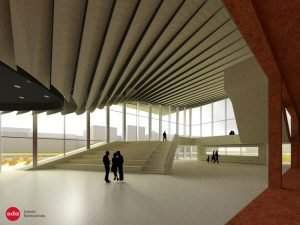The new National Dance Theatre to be built at Millenáris

According to index.hu, the National Dance Theatre had been functioning in the Carmelite Monastery in the Buda Castle until recently, when it was decided that the monastery would be turned into a prime ministerial residency. So the theatre had to leave in 2014. It was decided that their new home would be at the Millenáris Theatre, which is going to be reconstructed, therefore the company has to perform at alternative locations for one and a half years. The process of moving is not going quite smoothly, but it seems that the final result will be perfect.
Gábor Zoboki presented the plans – made by his office – about the reconstruction last week. He is quite experienced in the subject since he designed one of the coolest public buildings in Budapest, the Müpa (Palace of Arts), and he is also responsible for the works in the Buda Castle, so he probably knows the necessities of the dance theatre.
The location in question, the Millenáris Theatre was originally the transformation house of Ganz Művek, but when Millenáris was developed in 2001 the building was turned into a theatre. An interesting outdoor stage was added with a cool looking row of bells to make it the home of the most diverse performances.
The reconstruction will start in the beginning of next year and end in February 2018. It will cost a total of 3.3 billion forints, without the 608 million worth lighting and audio technology. So it is not a simple recoating.
According to the architect, the palette of Budapest’s cultural buildings is fascinating and it’s important that the National Dance Theatre gets a similarly high-standard home. This takes a professional location created for this exact purpose, which is spacious, and actors can enter from all directions.
The base is a symbolic space, since we’re talking about the generator house in the factory where Bláthy, Déri and Zipernovszky invented the transformer. Zoboki believes that dancers have to take on the heritage of these geniuses. For that matter, the building itself is an industrial memorial, so the basic structure of the basilica-like house will remain.
The most important change is the abolition of the outdoor stage, where a foreground will be formed as it wasn’t made during the original construction at the millennium. The architect said that a good theatre building has a head, thorax and swag-belly (foreground, stage and serving area), however this practically doesn’t have a head now or, at least, it is undeserved for a theatre.

Gábor Zoboki thinks that “Millenáris has sagged a bit” but the dance theatre can be the first step in the revival of the whole neighbourhood, parallel with the development of a new park zone. He hopes that the same renaissance flourishment will start in the region that started after the inauguration of the park.
The new hall will get a street front deserving for a theatre. “A chamber hall is dropped into this roof just like strawberries are dropped into the yoghurt in a Danone commercial.”
The main hall will be even bigger or, at least, it could be used more diversely. There won’t be a harsh line between the auditorium and the stage. It can be one-spaced, inclined, and even transformed into a runway, conference hall or movie theatre. It’s important that the location could be used all year round.
The theatre will be able to fit 350-400 spectators on average if there are no seats inside. The designers try to think about the future, because the needs might be different 10-20 years from now. Even a dinner of 200 guests could be organised there, without the dinner being served from the scenery of The Bohemian Life like it happened in the Opera before.
However, the most spectacular novelty for most people will probably be the facade and the guest-hall behind it. The architect believes that a lot depends on being able to fill the hall with life during the day as well. The life of the Royal Festival Hall was solved by two restaurants as well. The plan is to open cafés, restaurants which will be worth a visit for the locals.
He wants to create place where sitting on the stairs is an experience, but a smaller stage can also be set up and the stairs can be turned into an auditorium with pillows and rugs. As he said, many people hate the declivous inner stairs of Müpa, but he specifically likes these “runway-like baroque stairs”. So the main question is whether or not the new home of the National Dance Theatre will be the first step of a revival.
Photos: www.zda.hu
Copy editor: bm
Source: http://index.hu/





